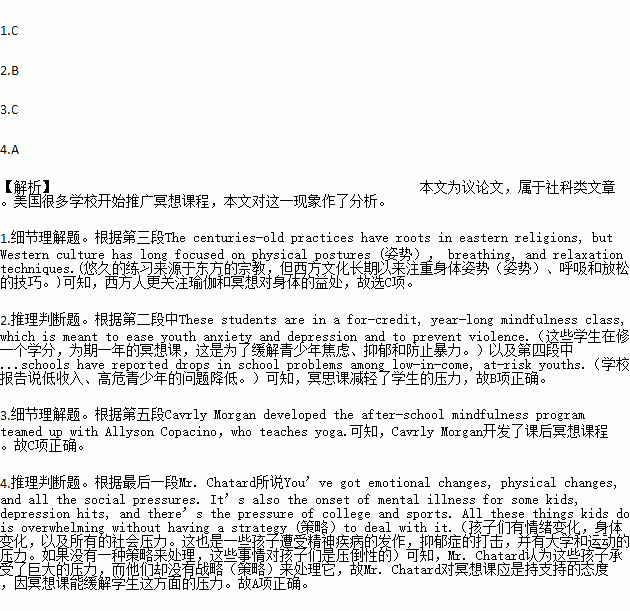题目内容
As the morning school bell rings and students rush in, teenagers in one classroom settle onto mats and meditation(冥想) pillows. They fail silent after the teacher taps a “singing bowl”.
These students are in a for-credit, year-long mindfulness class, which is meant to ease youth anxiety and depression and to prevent violence. For 90 minutes, three days a week, they practice a mix of yoga, sitting, and walking meditation, deep breathing, journaling, and non-judgmental listening.
Yoga and meditation have gained popularity among Americans in recent decades, supported by studies showing benefits to emotional, mental, and physical health. The centuries-old practices have roots in eastern religions, but Western culture has long focused on physical postures (姿势), breathing, and relaxation techniques.
Some people have greeted the move with less than enthusiasm. Last year, an elementary school in Ohio ended its mindfulness program after parents complained it was too closely linked to religion. But many school districts are reporting success. In Richmond, California, schools have reported drops in school problems among low-income, at-risk youths. The school district in South Burlington, Vermont, introduced a successful mindfulness course as part of a health and wellness program, and now administrators there have advocated mindfulness into K-12 curriculums.
Two years ago, Caverly Morgan developed the after-school mindfulness program teamed up with Allyson Copacino, who teaches yoga. After hundreds of students signed up, Principal Brian Chatard took note. The school was dealing with a student' s suicide (自杀), and few resources were available to address students’ emotional and mental health.
“High school is the hardest period of time for kids,” Mr. Chatard said. “You’ve got emotional changes, physical changes, and all the social pressures. It’s also the onset of mental illness for some kids, depression hits, and there’s the pressure of college and sports. All these things kids do is overwhelming without having a strategy (策略) to deal with it. ” And now schools all over the country are introducing the practices.
1.What do Western people value more about yoga and meditation?
A. Non-judgmental listening. B. Religious meaning.
C. Physical benefits. D. Journaling.
2.What can we infer about the mindfulness class?
A. It is supported by parents.
B. It relives pressure of students.
C. It mainly builds students up physically.
D. It improves students’ academic performance.
3.Who started the mindfulness class?
A. Administrators. B. Brian Chatard.
C. Caverly Morgan. D. Allyson Copacino.
4.What is Mr. Chatard’s attitude towards the program?
A. Supportive. B. Concerned. C. Doubtful. D. Reserved.
 全能测控期末小状元系列答案
全能测控期末小状元系列答案

 ),并在其下面写出该加的词。删除:把多余的词用(\)划掉。
),并在其下面写出该加的词。删除:把多余的词用(\)划掉。